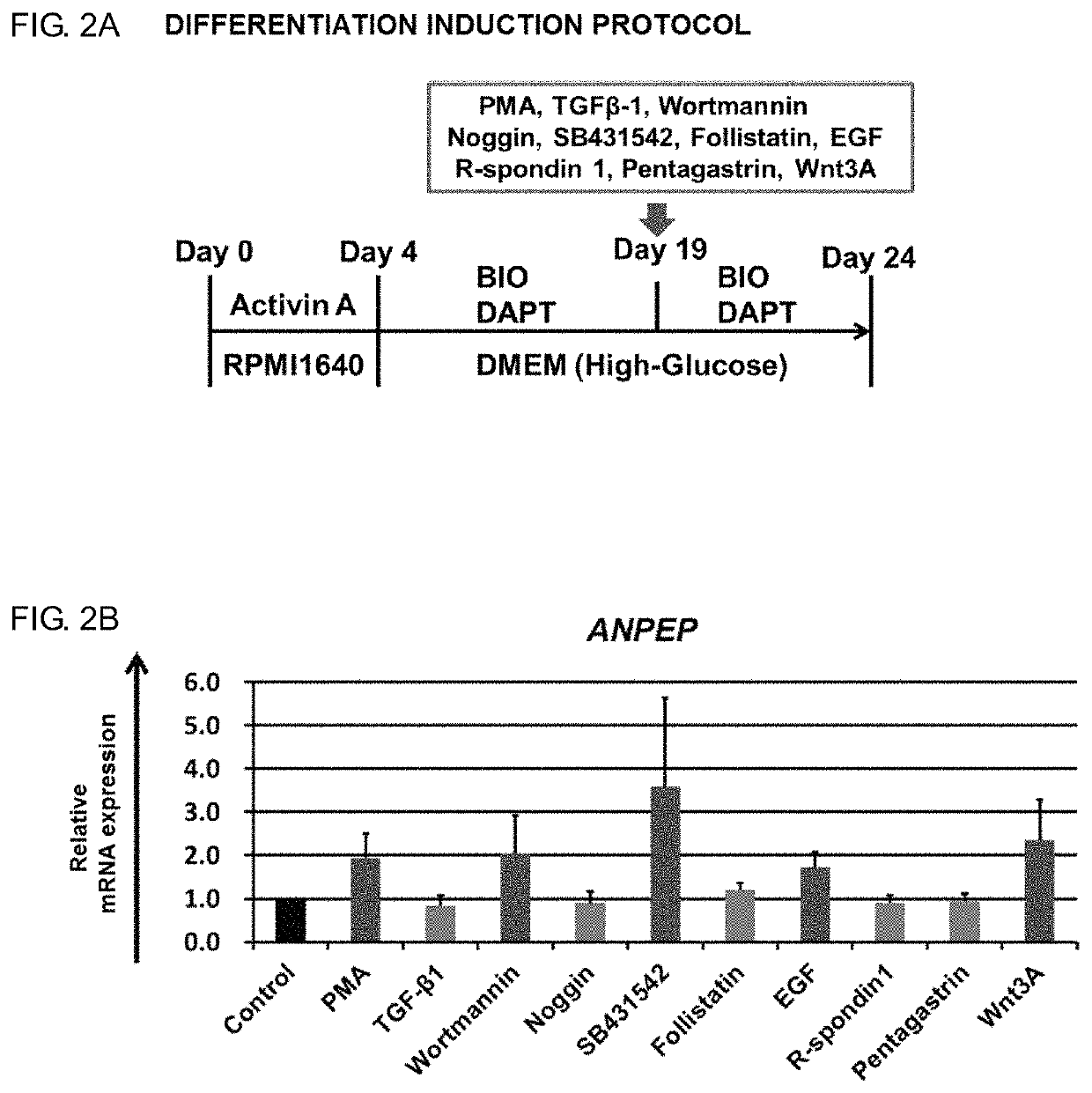Intestinal epithelioid cells
a technology of epithelioid cells and intestines, applied in the field of intestinal epithelioid cells, can solve the problems of low expression of the drug-metabolizing enzyme cyp3a4 (cytochrome p450 3a4), no report that enterocytes that enable simultaneous evaluation of drug metabolism and drug absorption have been able to be efficiently generated, and no report of differentiation to enterocytes using such vector systems, etc., to achieve efficient generation of enterocyte-
- Summary
- Abstract
- Description
- Claims
- Application Information
AI Technical Summary
Benefits of technology
Problems solved by technology
Method used
Image
Examples
reference example 1
Compositions of Various Types of Media
[0073]Various types of media are required for human iPS cells or human ES cells in the culture method shown in Examples of the present invention. In Reference Example 1, compositions of culture media that may be used for various types of cultures are described.
[0074](A) As a medium for maintaining an undifferentiated state of human ES / iPS cells, a medium for maintaining various types of stem cells including REPROSTEM (product name), IPSELLON (product name), ESSENTIAL 8 (product name), TESR-E8 (product name), and the like supplemented with bFGF may be used. The medium is hereinafter referred to as “medium 1”.
(B) As a medium for differentiation induction, a medium containing HESF-GRO (product name, CELL SCIENCE & TECHNOLOGY INSTITUTE, INC.), which is an essential medium for culturing ES cells, supplemented with insulin (10 μg / ml), transferrin (5 μg / ml), 2-mercaptoethanol (10 μM), 2-ethanolamine (10 μM), sodium selenite (20 nM), and BSA (1 mg / ml) m...
example 1
Generation of Definitive Endoderm Cells
[0075]In this Example, the generation of definitive endoderm cells to be used in the following Comparative Example and Examples is described. The definitive endoderm cells were generated using human iPS cells or human ES cells as pluripotent stem cells. In this Example, Tic (JCRB1331) was used as a human iPS cell line. A human ES cell line (KhES3) was handled in accordance with the guidelines of the Ministry of Education, Culture, Sports, Science and Technology, and experiments were performed with the approval of an ethics committee. The pluripotent stem cells were cultured using the medium 1 as feeder cells in accordance with a method described in Tiss. Cult. Res. Commun., 27: 139-147 (2008).
[0076]Differentiation induction treatment was performed by adding 100 ng / ml Activin A to the culture system of the human iPS cell line (Tic) and culturing the cells for 4 days. Thus, definitive endoderm cells for generating enterocyte-like cells in the fol...
example 2
Investigation of Method for Inducing Differentiation Using Enterocyte Markers (ANPEP and VILLIN) as Indicators
[0080]In this Example, with the use of enterocyte markers ANPEP and VILLIN as indicators, a method for inducing differentiation in which an improvement was made over the method for inducing differentiation of Comparative. Example was attempted.
[0081]The definitive endoderm cells generated from the human iPS cell line (Tic) by the method described in Example 1 above were further cultured for 15 days using the medium 3. During a period from day 4 to day 19 after the initiation of differentiation induction, BIO (5 μM) and DAPT (10 μM) were added to the culture system. Simultaneously with the addition of the BIO and the DAPT, the cells were further cultured for 5 days using the medium 3 supplemented with any one of phorbol-myristate-acetate (PMA), transforming growth factor β1 (TGEβ1), Wortmannin, Noggin, SB431542, Follistatin, EGF, R-spondin1, Pentagastrin, or Wnt3a (FIG. 2A an...
PUM
| Property | Measurement | Unit |
|---|---|---|
| concentration | aaaaa | aaaaa |
| permeability | aaaaa | aaaaa |
| resistance | aaaaa | aaaaa |
Abstract
Description
Claims
Application Information
 Login to View More
Login to View More - R&D
- Intellectual Property
- Life Sciences
- Materials
- Tech Scout
- Unparalleled Data Quality
- Higher Quality Content
- 60% Fewer Hallucinations
Browse by: Latest US Patents, China's latest patents, Technical Efficacy Thesaurus, Application Domain, Technology Topic, Popular Technical Reports.
© 2025 PatSnap. All rights reserved.Legal|Privacy policy|Modern Slavery Act Transparency Statement|Sitemap|About US| Contact US: help@patsnap.com



